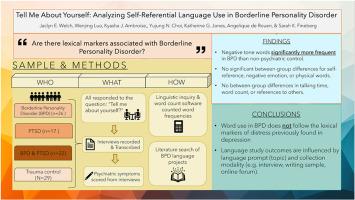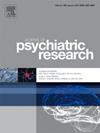Tell Me about yourself: Analyzing self-referential language use in borderline personality disorder
IF 3.7
2区 医学
Q1 PSYCHIATRY
引用次数: 0
Abstract
Depression and some other illnesses are associated with increased self-reference and negative emotion in language. Research findings on lexical patterns in Borderline Personality Disorder (BPD) have been inconsistent. We conducted two studies to evaluate lexical markers of distress in BPD: First compared to healthy controls (HC), and later compared to Post-Traumatic stress disorder (PTSD) patients and trauma-exposed controls (TC).
Study 1 compared language use in BPD (n = 23) to HC (n = 22). Study 2 featured a new sample comprised of 4 subgroups: BPD (n = 26), Post-Traumatic Stress Disorder (PTSD; n = 17), comorbid BPD + PTSD (n = 22), and one non-psychiatric trauma control group (TC; n = 29). All participants responded to a standardized prompt from an interviewer and language was analyzed using Linguistic Inquiry Word Count (LIWC) software to assess for self-referential language, negative emotion words, and physical words, as well as several other language signatures of interest.
No consistent significant between-group differences were found for LIWC categories of self-reference, negative emotion, or physical words, though negative tone words were significantly more frequent in BPD than non-psychiatric controls in both studies. There were also no consistent differences in sample length (either talking time or word count) or social measures across studies.
These data suggest that there are fewer lexical markers of distress in BPD language samples compared to previously reported depression and physical illness samples. Future work using longitudinal approaches to define changes in emotional and cognitive states will be important to clarify the disorder- and state-specificity of lexical markers.

跟我说说你自己分析边缘型人格障碍患者自我暗示语言的使用。
抑郁症和其他一些疾病与语言中自我暗示和负面情绪的增加有关。有关边缘型人格障碍(BPD)词汇模式的研究结果并不一致。我们进行了两项研究,以评估 BPD 的词汇标记:首先与健康对照组(HC)进行比较,然后与创伤后应激障碍(PTSD)患者和创伤暴露对照组(TC)进行比较。研究 1 比较了 BPD(23 人)和 HC(22 人)的语言使用情况。研究 2 采用了由 4 个亚组组成的新样本:BPD (n = 26)、创伤后应激障碍 (PTSD; n = 17)、合并 BPD + PTSD (n = 22),以及一个非精神创伤对照组 (TC; n = 29)。所有受试者都对访谈者的标准化提示进行了回答,并使用语言调查字数统计(LIWC)软件对语言进行了分析,以评估自我暗示语言、负面情绪词语、身体词语以及其他一些感兴趣的语言特征。尽管在这两项研究中,BPD 患者使用负性语气词的频率明显高于非精神疾病对照组,但在 LIWC 的自我暗示、负性情绪或肢体词类别中并未发现一致的显著组间差异。不同研究在样本长度(谈话时间或字数)或社会测量方面也没有一致的差异。这些数据表明,与之前报道的抑郁症和躯体疾病样本相比,BPD 语言样本中的苦恼词汇标记较少。未来使用纵向方法定义情绪和认知状态变化的工作对于澄清词汇标记的障碍和状态特异性非常重要。
本文章由计算机程序翻译,如有差异,请以英文原文为准。
求助全文
约1分钟内获得全文
求助全文
来源期刊

Journal of psychiatric research
医学-精神病学
CiteScore
7.30
自引率
2.10%
发文量
622
审稿时长
130 days
期刊介绍:
Founded in 1961 to report on the latest work in psychiatry and cognate disciplines, the Journal of Psychiatric Research is dedicated to innovative and timely studies of four important areas of research:
(1) clinical studies of all disciplines relating to psychiatric illness, as well as normal human behaviour, including biochemical, physiological, genetic, environmental, social, psychological and epidemiological factors;
(2) basic studies pertaining to psychiatry in such fields as neuropsychopharmacology, neuroendocrinology, electrophysiology, genetics, experimental psychology and epidemiology;
(3) the growing application of clinical laboratory techniques in psychiatry, including imagery and spectroscopy of the brain, molecular biology and computer sciences;
 求助内容:
求助内容: 应助结果提醒方式:
应助结果提醒方式:


